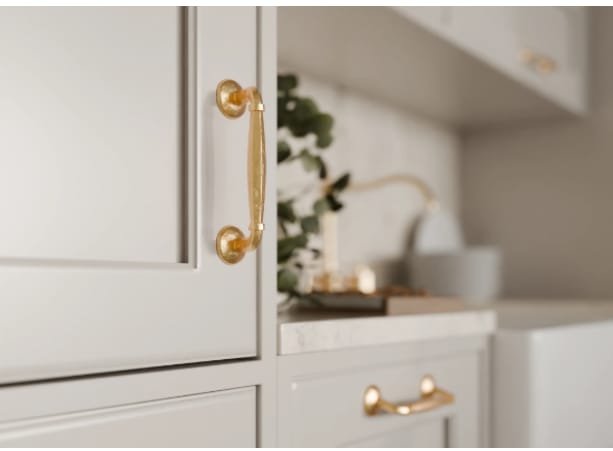
Design That Does Not Require Construction
A kitchen renovation is often imagined as a major undertaking. For many people, the image includes reconfiguring layouts, replacing cabinetry, and tearing out surfaces that once defined the room. But not all upgrades need to be large-scale to make a difference. Some of the most significant shifts in how a kitchen feels can come from the objects used every day. Cabinet hardware is one of those details. It sits at the junction of form and function, influencing how the space looks, behaves, and holds up over time.
Rather than beginning with demolition, consider starting with something smaller. Hardware changes do not require construction. They do not ask for plumbing changes or new appliances. But they do change the way a kitchen moves. They shift the experience of opening a drawer, reaching for a cupboard, or pulling open a pantry. These repeated interactions define how a kitchen feels in practice, not just in appearance.
Why Hardware Is a Design Decision, Not an Afterthought
Cabinet hardware is more than a finishing touch. It is part of the structure of the room. Drawer pulls and cabinet handles connect the hand to the surface. They create a tactile rhythm across the kitchen. And that rhythm affects how daily tasks are experienced. In many standard builds, hardware is selected quickly and installed without much thought. That leaves an opportunity. By replacing those basic parts with handles that feel right in both scale and material, the entire kitchen can begin to feel like it belongs to the person using it.
This is not about luxury for its own sake. It is about functionality that carries a certain presence. A handle that does not clatter when it is touched. A pull that feels balanced under weight. A brushed finish that resists marks but catches natural light in a subtle way. These are all decisions that shape the tone of the space. They are quiet, but they are persistent.
The Value of Solid Materials
Solid brass hardware carries weight in both a literal and figurative sense. It holds its form under pressure. It does not shift, wobble, or wear unevenly. It responds consistently to repeated contact, which is especially important in kitchens where cabinets and drawers are opened hundreds of times each week.
Here is what sets solid brass hardware apart:
- Durability: Withstands high-touch use without degrading over time
- Stability: Resists loosening or shifting in high-traffic areas
- Consistency: Maintains tone and finish with regular cleaning
- Weight and balance: Feels substantial in the hand, creating a sense of quality
- Brushed finishes: Reduce fingerprints, glare, and surface shine for a calm visual experience
P’Amour’s collection of brass kitchen cabinet handles is crafted for daily use with all of these qualities in mind. These are not decorative extras. They are foundational parts of a well-functioning kitchen.
Changing the Room Without Changing the Structure
The idea of a custom kitchen can feel out of reach for those not planning a full renovation. But customization is not always about layout or cabinetry. It is about intention. A kitchen that feels custom often has hardware that suits the size of each cabinet, that matches the user’s movement patterns, and that aligns with the materials already in the room.
That means small changes can add up. A wider drawer gets a longer pull. A narrow upper cabinet gets a centered knob or shorter handle. When the hardware proportions are matched to the space, it stops looking generic. And because the handles are installed at the same drill points as the originals, these updates require no structural change.
This kind of update also respects existing materials. If the cabinetry is still in good condition but the space feels visually tired, hardware can renew the tone without discarding what still works. Brass kitchen cabinet handles, in particular, have the flexibility to work with painted cabinets, wood tones, or even textured laminates. They sit quietly in the background, creating cohesion without demanding matching finishes elsewhere.
Fit and Feel Over Statement
The best kitchen updates are often the ones that do not announce themselves. A brass handle with a brushed finish does not compete with a kitchen’s other features. It supports them. It works alongside stone surfaces, tile backsplashes, or wooden countertops without forcing contrast. Its tone is warm but not showy. Its finish reduces shine rather than reflecting it.
This is important in a kitchen that serves multiple purposes. In many homes, the kitchen is both a workspace and a gathering space. A handle that feels cold or glossy can disrupt the balance. A brushed finish, especially in a brass tone, blends more naturally with the layered materials typically found in a working kitchen. It allows the room to feel resolved even when elements like appliances or fixtures do not match perfectly.
Why Standard Hardware Often Falls Short
In many standard kitchens, the hardware is chosen for cost, not comfort. Over time, these compromises become visible and tangible. Here is what often goes wrong:
- Thin materials that bend, rattle, or wear unevenly
- Sharp edges that feel uncomfortable under repeated use
- Loose fittings that shift or come undone over time
- Coatings that fade, scratch, or peel with cleaning
These flaws may seem small, but they accumulate. A drawer that feels unstable. A cabinet that clangs. A finish that no longer matches its surroundings. Upgrading hardware fixes these interactions directly. And that shift is something people notice every day.
Quiet Design That Lasts
Brushed brass is not dependent on trend cycles. It has remained relevant across decades of kitchen design because of its neutrality. It does not overwhelm, but it does support. It pairs easily with contemporary layouts, transitional spaces, and more traditional kitchens. It can sit next to matte black, brushed nickel, or stainless steel without creating tension.
This finish allows a kitchen to evolve. It feels appropriate whether the space is new or inherited. And when installed across drawers, cabinets, and pantry doors, it creates a visual continuity that often cannot be achieved through any other single update.
The Impact of Touchpoints
There is a difference between looking at a kitchen and using one. The second category depends on touch. It includes the way a handle feels in the hand. Whether the finish feels smooth or grainy. Whether it clinks or moves quietly. These moments repeat so often that they begin to shape the entire feel of the space.
Choosing the right hardware creates a pattern of positive interactions. Every touch feels resolved. That resolution adds up. It makes the kitchen feel more stable. More usable. More aligned with the people who live there.
Final Thought
Custom does not always mean starting from scratch. Sometimes, it means replacing the parts that are used most. Brass kitchen cabinet handles offer a grounded, tactile way to update the kitchen without redesigning it. These are not decorative flourishes. They are functional changes with material intent.
At P’Amour, each piece is built to last through years of daily use. Quiet finishes. Solid forms. Designs that do their job without fanfare. Explore the full collection at p-amour.com to see how small-scale updates can carry long-term value in kitchens that are meant to be lived in.



